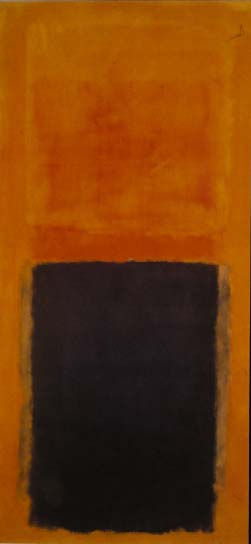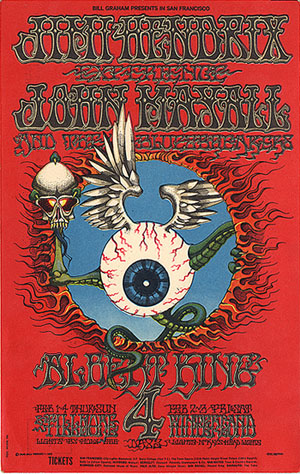Schwarz
View current page
...more recent posts
"The real challenge," Stockhausen wrote to me, "is to find seven stage directors and stage designers, seven conductors, five orchestras, one children's orchestra, nine professional choirs, two children's choirs, one girls' choir, seven sound projectionists, seven sound technicians, many soloists. This is all possible if one can engage the ensembles and soloists who have already performed parts of Light quasi-scenically in concerts and rehearse in seven auditoriums daily for about six months."
BG-105
the soul artists of zoo york
via record brother whos posting the crazy shitz on the regular
terry riley le secret de la via (1975) / no man's land (1985) mp3s
via kenny g fmu blog
GRAV, the Nouveaux Réalistes, BMPT and Support-Surface propounded all manner of theories on the ends and means of art and the destiny and political role of the avant-gardes. The Marxist synthesis of structuralism and Lacanian psychoanalysis did much to shape the deliberately speculative nature of these attempts at self-definition and positioning. The extent and importance of this critical activity during the 1970s is evidenced by the existence of such reviews as Cahiers théoriques, Macula and Documents sur. This linking of art and the human sciences, which still obtains today in somewhat abated form, became the defining characteristic of contemporary art in France. Among its innumerable consequences was the strangely tortuous procedures that artists had to take to express their subjectivity.
Much has been written about the parallels between the critical intuitions of Frank Stella and those of GRAV, and about the different conclusions drawn on each side. The heritage of Duchampian kinetics had a decisive influence on François Morellet, Julio Le Parc and Jesus-Rafael Soto, (although this reading of it has been totally neglected since), as did the Zurich Concrete Artists (including Max Bill and Richard P. Lohse), Auguste Herbin, Jean Dewasne and Victor Vasarely. These figures constituted a unifying matrix for the work of artists from a wide variety of backgrounds.[27] The interest in movement, which was expressed most literally in the work of Jean Tinguely and Pol Bury, moved many artists to translate it into pictorial form, to attempt the simultaneous use of illusionistic and interactive procedures. With its abstract anamorphoses, its ever-more sophisticated apparatus, its games with parallaxes and mirrors, the work of the GRAV group was aimed at the widest-possible public. As they proclaimed in their Manifesto (1963), “We Want to interest the spectator, to remove his inhibitions, to get him to relax.”
Much of the intense work and the sparks that flew between Kahn and Noguchi during the five years of their collaboration (1961-66) found their way into the design of Moerenuma Park in Japan.
A testament to what can be achieved when public officials, artists and the general public work together, the park was completed after Noguchi's death under the guidance of the Isamu Noguchi Foundation, architects Shoji Sadao and Junichi Kawamura (longtime Noguchi collaborators), Kitaba Landscape Planning, Park Director Hitoshi Yamamoto and city officials working with the support of the citizens of Sapporo.
Their achievement is phenomenal and incorporates a full range of Noguchi's work in stone, concrete, wood, metal and fiberglass. More importantly, it showcases his talent for using the sun, sky, Earth and the horizon as his true materials.
Gulf Coast: A Vision to Revive, Not Repeat
By ROBIN POGREBIN for nyt
Published: October 13, 2005
BILOXI, Miss., Oct. 12 - The work facing architects and urban planners who convened here today at a battered resort is visible right outside the window. A beach strewn with uprooted trees and the detritus of ravaged buildings. Deserted streets lined by flooded empty houses. Hulking casino hotels gone dark.
Over the next several days, this group of some 200 professionals from around the country will struggle to come up with a comprehensive regional plan to rebuild the Mississippi Gulf Coast. It's a design challenge on a grand scale, covering 11 communities in 3 Mississippi counties damaged by Hurricane Katrina.
paul rudolph tracey towers up in the bronx

black betty table
leanon coat rack
brackets included steel shelf
cloud meeting room
slow cruise on the highline
The Lower Manhattan Development Corporation (LMDC) has announced that it will launch a series of public workshops to determine the programming for the future Memorial Museum. The museum, to be located at the World Trade Center site, will include fragments of materials from both the 1993 bombing and the 2001 attack. In collaboration with the Civic Alliance to Rebuild Downtown New York and New York New Visions, each workshop will feature a presentation of preliminary programming concepts, currently by developed by curatorial planners Howard+Revis Design Services, Inc., institutional planning consultant LORD Cultural Resources Planning and Management, Inc., and the LMDC. The workshops will offer the public the opportunity to discuss their expectations for the Memorial Museum and to comment on the preliminary concepts. The final recommendations of the Memorial Center Advisory Committee can found on the LMDC’s website: www.RenewNYC.com/memorial.
more afghan war rugs

mark rothko - homage to matisse (1953)
you think your dad was tough - mp3 of murray wilson and the boys from the help me ronda sessions - in parts or the full 40 min version
Only weeks after the world lost the great R.L. Burnside, another stellar light of both the Fat Possum label and music in general has passed away; Paul "Wine" Jones died of cancer in Jackson, Mississippi on Sunday. He was age 59. His two discs Mule (1995) and Pucker Up Buttercup (1999) were pretty much in the similar vein of so many of his labelmates also plucked from obscurity and saddled in Oxford, Mississippi studios by FP chief excavators Matthew Johnson and Bruce Watson: raw, blazing display of an ever-dimming continuum between the roots of Delta jukejoints, Fred McDowell-style ass-shaking repetition and today's primitive blues done with pure spirit. With Junior Kimbrough, Asie Payton, RL Burnside and now Jones gone, that thread gets sadly thinner. Wine's sound was all his own vocabulary, and in the end influenced really by no one but himself and his surroundings. Buttercup is a fractured and odd blues record which at times rips speakers to shreds; it's the sound of someone barely familiar with a studio telling his story (joined by a fellow named Pickle on drums) in distortion-flecked sketches right down to the finale, appropriately titled "I Guess I Fucked It All Up." We at WFMU had the distinct pleasure of witnessing the man in action as he joined Kenny Brown and T-Model Ford for a hard-to-believe-they-were-rocking-AND-drinking-at-9AM live performance on David Suisman's Inner Ear Detour show back in 2004. Listen to his 4-song set here! (Real Audio) And also check out Pucker Up Buttercup's "Goin' Back Home" from another Inner Ear Detour show here (Real Audio). And, if you get a chance, do check out the excellent DVD documentary You See Me Laughin', which traces the story and the intertwining lives of many of these, the very last of the Hill Country Blues men. A third Jones album was in the works according to the Fat Possum catalog page that was originally due in January.via brian turner on fmu blog
a revamped wfmu beware of the blog w/ more bells and whistles
Porch Posts, Balusters, Rails, Etc.
The pumps at Station No. 1 are arranged in a neat row, their suction pipes reaching down under the building to connect to the city's vast network of drainage canals. The 12-foot 1913 pumps, designed by the engineer Albert Baldwin Wood, are still here, as are four more he designed in 1928. The last two, the biggest and most powerful, were built in the mid-90's.
The night of the storm, Mr. Martin said, "the two new pumps went out right away. They're the most powerful. They sound like freight trains. Four of the old ones kept going all night. The original two pumps, those are the most reliable. I'd use those two before I'd use any of the others."
He walked to the back of the shed, where two towering wood doors are held in place by heavy braces. As the storm picked up speed that night, 100-mile-per-hour winds pounded the doors, threatening to tear them from their frames. If the storm waters flowed past them, he knew, the station would stop functioning. So he threw himself against the doors, struggling to hold them back while screaming for help over the roar of the machines. The other men came running to help, jamming the wood braces between the doors and the machines. That night, the pump stations kept the city from flooding.
I also knew, or thought I knew, that right up to Thursday night, there had been just two houses in Uptown New Orleans with people inside them. In one, a couple of old coots had barricaded themselves behind plywood signs that said things like "Looters Will Be Shot" and "Enter and Die." The other, a fortlike house equipped with a massive power generator, was owned by Jim Huger - who happened to grow up in the house next door to my parents. (When I heard that he had the only air-conditioning in town and I called to ask if I could borrow a bed, he said, "I'm that little kid you used to beat on with a Wiffle Ball bat, and I gotta save your ass now?") In Jim Huger's house, until the night before, several other young men had holed up, collecting weapons and stories. Most of these stories entered the house by way of a reserve officer in the New Orleans Police Department, a friend of Jim's, who had gone out in full uniform each day and come back with news directly from other cops. From Tuesday until Thursday, the stories had grown increasingly terrifying. On Thursday, a police sergeant told him: "If I were you, I'd get the hell out of here. Tonight they gonna waste white guys, and they don't care which ones." This reserve cop had looked around and seen an amazing sight, full-time New Orleans police officers, en masse, fleeing New Orleans. "All these cops were going to Baton Rouge to sleep because they thought it wasn't safe to sleep in New Orleans," he told me. He had heard that by the time it was dark "there wouldn't be a single cop in the city."
Jean Prouvé: Three Nomadic Structures
MOCA
Pacific Design Center
Los Angeles, California
"He combines the soul of an engineer with that of an architect.”
--Le Corbusier
Prouvé (1901–84) sought to create furniture and simple lightweight metal building systems whose constructive logic permitted easy fabrication and use. His major preoccupation was with prefabrication technology for architecture, and all his work, from cafeteria chairs to public buildings to new solutions for temporary housing, adheres to the dictum "Never design anything that cannot be made.
arie kaplan
Kings of Comics, How Jews Created the Comic Book Industry
Knowing that I'm both a huge comic book fan and a writer for MAD Magazine, Reform Judaism Magazine recently asked me to write a three-part series on the history of Jews in comic books, "Kings of Comics". I got to interview industry legends like Will Eisner, Stan Lee, Jerry Robinson, and Joe Kubert, newer talents like Jon Bogdanove and Chris Claremont, and even my MAD colleagues like Drew Friedman, Peter Kuper, and Al Jaffee.
...............................................................................................................................................................
Wizards of Wit - How Jews Revolutionized American Comedy
Reform Judaism Magazine wanted to write a series on Jewish Comedy Writers, so they chose (who else?) a Jewish Comedy Writer. I'm very proud of this series, especially since I got to interview some of my heroes, including Carl Reiner, Larry Gelbart, Paul Peter Porges, Nora Ephron and Lewis Black, among many others
thoughtography

